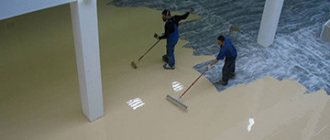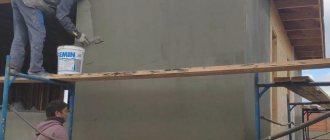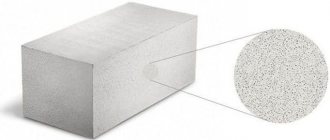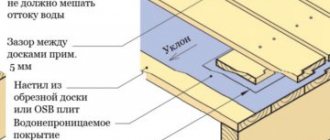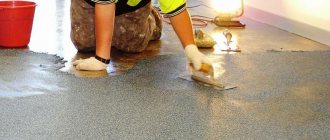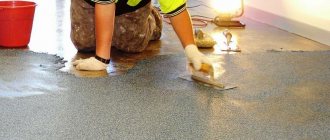Beton-House.com
Website about concrete: construction, characteristics, design. We combine the experience of professionals and private craftsmen in one place
The available color palette depends on the type of paint and manufacturer
Concrete is considered the most profitable building material in all respects: convenience/price/practicality/durability. This is true, the main thing is to properly protect it from its inherent shortcomings. Wear-resistant concrete floor paint suitable for any operating conditions will serve this purpose well.
It can be used in the garage, for paths in the garden, landscaping the area around the house and, of course, in residential premises, as well as for large civil facilities and industrial workshops.
How to paint a concrete floor with your own hands
Painting protects the floor from various influences and improves its decorative qualities. Therefore, it is important to know how and with what to paint a concrete floor in order to preserve and enhance its advantages and minimize its disadvantages. Painting compositions used for floor finishing differ in the set of components and place of application.
Surface protection and care
Cleaning the self-leveling floor is easy, and it is permissible to use vacuum cleaners, mops, including steam mops. Due to its good wear resistance, this coating can withstand the effects of many detergents. Moreover, the absence of joints allows cleaning quickly and without problems. You can periodically apply wax or polish to prevent scratches.
Due to its good wear resistance, this coating can withstand exposure to many detergents.
Coating a concrete floor with epoxy is easy. Following safety measures and carefully preparing the surface will allow you to obtain a beautiful and stable coating that will last for a long time.
Types of paints for exterior use
Paints and varnishes for concrete are divided according to their purpose and place of use. If most paints can be used for interior work, then for exterior use it is worth choosing certain types of dyes. After all, the coating they create should be as resistant to various adverse factors as possible. Painting compositions used outdoors are divided into two groups according to the method of dilution:
- To create the required viscosity, diluted with water. They contain synthetic resins, fillers and coloring pigments. They can only be painted in warm weather. The coating they create can last 10 years.
- Compositions that are diluted with xylene, solvent or white spirit to achieve working viscosity. Their application is possible in any weather. Among their disadvantages, it is worth noting the fire hazard and the presence of toxic substances.
There are many types of paints for concrete.
Limestone
One of the options for painting a concrete floor is lime dyes. They are suitable for those who are interested in what paint to use to protect concrete from contamination. Before painting, the concrete surface must be primed and leveled. For outdoor work, we choose a lime composition with natural drying oil and paint only in cloudy weather, otherwise the coating will be uneven.
By the way! Lime paint is easy to prepare at home using alkaline pigments. Since lime is an alkali, the pigments must be alkali-resistant.
Water-based
This is one of the types of concrete paints that do not contain toxic substances. It contains only distilled water and binders. Therefore, for those who are interested in which odorless paint is better to paint the floor, water-based emulsion is recommended. Moreover, this paint for concrete floors is wear-resistant, because when painting, the water evaporates, and the remaining elements of the dye form a durable film. However, after painting and drying the composition, the surface will not lose its ability to breathe. Painting with water-based emulsion differs in the ease of application. This finishing option is relatively inexpensive.
Water-epoxy
Another variety is a water-based epoxy two-component paint for concrete floors. This enamel consists of two components that are mixed before application. The composition obtains the necessary strength characteristics after mixing with a hardener. Coloring can be carried out at any temperature.
To prevent moisture evaporation, epoxy paint for concrete floors is often applied to freshly laid concrete, which helps to increase its strength. Epoxy paint for concrete floors does not lose color. Due to the possible release of harmful substances, such finishing is not used indoors.
Oily
This is another type of concrete paint. In the recent past, oil formulations were the most common. Oil compositions are a mixture of drying oil, fillers (barium sulfate, talc, barite) and pigments. Surfaces painted with them take a long time to dry and smell strongly. The dense film that forms after drying does not allow the surface to breathe. But one of the requirements for concrete paints is the vapor permeability of the coating. Today, the use of oil formulations is limited.
Acrylic
The most common type of dye is acrylic paint for concrete floors. It is based on polymers and polyacrylate resin. Painting is allowed not only outside, but also indoors, since this polymer paint for concrete floors is safe. Thanks to the elastic film layer formed after painting, acrylic paint for concrete floors is wear-resistant. Provides ventilation of the painted surface due to the vapor-permeable ability of the coating. Acrylic-based compositions have a rich range of colors.
Acrylic silicone
Thanks to resins and polymer additives, acrylic-silicone paint for concrete floors is wear-resistant. The increased adhesion of acrylic resin firmly holds the coating on concrete. This two-component concrete floor paint combines the advantages of acrylic and silicone varieties of dye. Thanks to the silicon contained in silicone resins, this concrete floor enamel creates a durable coating. The disadvantages of acrylic-silicone dyes include a limited range of colors.
Latex
To produce latex paint, synthetic rubber is used - an emulsion of polymer particles. To improve the performance characteristics of this paint, manufacturers supplement its composition with epoxy, polyester and alkyd resins or polyurethanes. Each of these additives affects the properties of the dye. Therefore, when choosing the best way to paint concrete surfaces, you need to pay attention to the label, which indicates the purpose of the product.
Polymer and vinyl
To protect concrete surfaces, several types of polymer coatings based on polyurethane, epoxy and acrylic are used. Therefore, before painting a concrete floor, you need to choose a suitable coating. When choosing, you need to take into account: the condition and quality of the base, requirements for properties and durability of the coating. For weak concrete, polymer impregnation must be used. Vinyl paint, once quite popular, is not in great demand today. Its undoubted advantage is its affordable price. When used in facade finishing, vinyl coating quickly loses its performance properties from exposure to chemicals and mechanical damage. After drying, it shrinks strongly.
Features of rubber paint
One of the new varieties is rubber paint for concrete floors. It is made from acrylic polymers, silicone additives and other substances. Semi-matte water-based rubber paint for concrete floors does not contain solvents or other harmful substances, which makes it absolutely safe for humans. The absence of odor makes it possible to use rubber paint for concrete floors both outside and indoors, especially since it does not release harmful substances when it dries. Incredibly elastic rubber paint for concrete floors from the Ecoross company has found wide application in protective and decorative finishing. Ecoross dyes have good adhesion. This is one of the options for quickly protecting and removing dust from the floor surfaces of industrial premises.
Polyurethane paints
Polyurethane enamel chosen for a concrete floor has increased requirements for the condition of its surface. This type of enamel is applied to a dry, pre-leveled base. Because after drying, polyurethane paint for concrete floors creates a thin layer coating that does not provide leveling. Due to its resistance to UV rays, polyurethane enamel for concrete bases does not require additional protection.
Do you need putty?
Putty is one of the most common means for sealing joints.
Putty for a concrete floor is the best way to protect the coating from further destruction. The monolithic structure has good strength characteristics and is little susceptible to negative environmental influences (temperature expansion, moisture). But if any cracks or chips appear on the surface, the technical parameters of the base deteriorate sharply.
To influence the service life of the mineral base, concrete floor putty is used. It is used to treat seams, joints, cracks, potholes and chips on the surface, which prevents damage to the coating. Depending on the composition, the putty can be:
- Cement - prevents the penetration of moisture into cracks, but under certain conditions it causes significant shrinkage;
- Epoxy - helps eliminate unevenness on the base and protect vulnerable areas from acids and alkalis;
- Gypsum – helps level the floor, but does not have water-repellent properties;
- Acrylic - a non-hygroscopic mixture does not shrink and helps level the coating.
You can also putty the mineral base with varnish, glue, oil and other types of putty. However, they are in less demand due to the impossibility of using them in high humidity conditions.
Foam varnish
Paintwork materials that protect concrete also include polystyrene foam varnish for painting concrete floors. It is easy to prepare at home. Do-it-yourself paintwork will have the same properties as the finished product, and the cost will be an order of magnitude lower. To prepare polystyrene foam varnish for painting a concrete floor you will need:
- 0.5 l of acetone (or gasoline);
- 0.25 l xylene;
- a piece of foam plastic measuring 60x60 cm.
Then perform the actions in the following order:
- We break the foam into small pieces for quick dissolution.
- Pour acetone and xylene into a metal container.
- Pour a portion of foam pieces into the jar. We press them with a wooden stick to immerse their solvent.
- The foam will begin to quickly dissolve and the liquid will thicken. In this case, there will be an active release of gas contained in the foam.
- As it dissolves, add a new portion of pieces. To speed up the process, shake the container periodically.
- When all the foam has dissolved, close the container with a lid and leave to infuse.
- When the polystyrene varnish has set, paint the concrete floor with a brush or spatula.
How to paint concrete surfaces
In fact, it is important to know not only how and with what to paint a concrete floor, but also how to prepare the surface for applying the material. After all, the quality of painting largely depends on the preparation of the concrete base.
Preparation
Before performing any actions with the screed, it must be inspected, cleaned and cracks repaired. It is better to remove old paintwork using a spatula or a grinder. Then use a vacuum cleaner to collect debris and dust.
Primer
If a concrete floor enamel manufacturer recommends pre-priming, it must be done. Some primers are applied in two layers.
Important! When choosing a primer, you need to consider its compatibility with the dye being applied.
Primer application
To prevent dust formation and better adhesion of paintwork materials to the base, a special composition is applied - a primer. It penetrates deeply into the concrete structure, helping to compact the rough surface. As primers dry quickly, they lose their sticky properties. Manufacturers produce primers in two forms - ready-to-use and concentrated. Primers of this type are bitumen, polyurethane and epoxy.
Today different types of this material are produced. Each type has different performance characteristics, so you need to use a material suitable for concrete surfaces. Regardless of the type of material selected, when applying a primer, the following actions are performed:
- Before using the finished mixture, stir it thoroughly.
- A layer of primer is applied to a dry, dust-free base.
- After the first layer has dried slightly, repeat the application of the solution.
- Allow the primer coat to dry completely.
Decorating floors with polymer coating
Glitter, chips, flocks, etc. are used to decorate floors. The inclusion of various small elements in the surface composition allows you to give the floor an original look and hide minor defects.
Particles are poured into the coating that has not yet hardened using a spray bottle or manually; the excess is removed after the floor has hardened. Next, clean the base and varnish in 2 layers.
3D floors have become very popular, which involve laying a banner film/fabric with an image on the base, and filling it with a transparent polymer coating on top. You can also lay different stones, flowers, coins, herbs, create patterns and ornaments.
All decorative elements are laid out on the base floor, then filled with a transparent wear-resistant layer. The decor can be anything - it all depends on imagination and possibilities.
Popular primer compositions
Among the primers that are in demand in the building materials market are primer compositions of the following brands:
- Ceresit CT 17. universal impregnating composition of deep penetration. Maintains the permeability of the surface layer. Adding a coloring pigment to the composition simplifies the application of the primer.
- Knauf Tiefengrud. A universal primer with high penetrating ability. Designed for impregnation of super-hygroscopic materials.
- Knauf Concrete contact. The primer is a polymer dispersion with pink quartz sand. The product is ready to use. Designed for coating poorly absorbent substrates.
Different dyes may have specific applications. Therefore, before painting, you must read the instructions and follow the manufacturer’s recommendations.
Why paint concrete
Many will find it strange that a concrete base needs to be protected. However, its porous structure allows various elements to penetrate into the depths, which can lead to deterioration of the material.
So, over time, under the influence of various factors, such as temperature changes, high humidity, mechanical stress, the quality and wear resistance of all floors suffers. Also, concrete does not withstand the effects of chemicals. All these negative factors will lead to too rapid deterioration of the material.
Therefore, painting the floor surface with epoxy concrete paint can significantly improve its wear resistance and increase the service life of the floors.
Painting the surface of the floor with epoxy concrete paint can significantly improve its durability and increase the life of the floor.
Manufacturers of paint and varnish products
It is no secret that the highest quality products on the market are supplied by companies that have extensive experience in their production. And the cost of products from well-known brands is higher, but, nevertheless, experts recommend giving preference to them.
Next, manufacturers of paint and varnish products popular among domestic craftsmen will be presented.
| Illustration | Brief information about the company |
| Mitsar is a manufacturer from St. Petersburg with a 12-year history, a regular supplier of paints and varnishes for enterprises within the framework of the State Defense Order. This means that the company’s products, with similar or better characteristics in comparison with analogues, have the lowest price (the difference is up to 4-5 times). Painting materials "Mitsar" are used by the state holding "United Shipbuilding Corporation" for painting military and civilian ships. Also, Mitsar enamels with increased acid resistance and anti-corrosion properties were used in the construction of the Leningrad and Kola nuclear power plants. | |
| Tikkurila is a famous Finnish company that is well known to Russians for its quality products. The company was founded in 1862, and during its operation it has accumulated vast experience in the creation of various paints and varnishes. In Russia, this company owns the Finncolor and TEKS brands, aimed at different price categories of products. | |
| Dulux is a world famous brand owned by. The birth of the brand can be considered in 1932; its creator was the British concern ICI. As experts say, “Dulux” and high quality can be called synonymous. The brand has a rich history, which is annually updated with new developments and awards. The assortment probably covers all types of paints and varnishes. | |
| “Aquastrong” is a Russian product that has been producing environmentally friendly water-based paint since 1998. During this period, the company achieved great success in the production of a variety of varnishes and paints, as well as materials for preparing surfaces for finishing. | |
| Lakra is a concern that includes several companies producing paint and varnish products. Products under this brand are manufactured in different countries of Europe and America - Canada, Switzerland, Germany, Poland, France, Estonia, and, of course, Russia. The company produces high-quality products certified to strict EU standards. Lakra is one of the three leading manufacturers of paint and varnish products. | |
| "PRESTIGE-HOLDING" is a Russian company that has been operating since 1998. All products are tested for compliance with the stated characteristics and safety standards. The most modern equipment is used in production. The products have earned many awards at Russian and international competitions. However, the main definition of quality is the positive reviews of numerous Russian consumers. | |
| “BIOFA” - this brand belongs to a German company that has been producing environmentally friendly paints, oils and oil-waxes from natural raw materials since 1982. Products have the highest quality certificates and are imported all over the world. |
Polyurethane
One way to protect the concrete surface and at the same time give it an attractive appearance is to use polyurethane dyes. Before applying polyurethane paint, the floor is prepared: dried, cleaned of dust, and oil (grease) stains are removed. Coloring is carried out in two stages, the second layer - no earlier than a day after the first.
The peculiarity of polyurethane-based paints is that they need from 2 to 14 days to dry completely. At the same time, the dye reaches a dry, tack-free state within a couple of days, after which small mechanical loads are acceptable.
During the remaining time, the polyurethane coating on the concrete floor continues to gain mechanical and chemical resistance. Using paint provides the following advantages:
- The dye is used for interior and exterior work and is highly resistant to weather vagaries.
Polyurethane two-component paint for industrial floors Source prom.st
Topping systems
Topping is a dry mixture used to harden the surface of a concrete floor (another name is hardening mixture). The technology has the following features:
- The mixture is applied to fresh concrete (immediately after laying). It is distributed over the surface; for large areas, a distribution machine is used.
Grouting industrial concrete floors Source mpkm.org
- Topping consumption depends on the expected load. If the load is small or medium, use approximately 3 kg/m². For medium or heavy loads, the flow rate is increased to 4-5 kg/m².
- The mixture absorbs moisture from the concrete mixture and darkens, after which it is pressed in with a trowel. The topping becomes one with the concrete base.
The basis (binder) of the topping, like concrete, is cement. Fillers are responsible for the functional properties: quartz, corundum (mineral or synthetic), iron carbide, and other compounds. Chemical plasticizer additives control the filling and shrinkage process. Thanks to coloring pigments, the topping can obtain any shade and texture (smooth or grainy), so it is convenient to use as a topcoat.
The use of topping systems has a beneficial effect on surface characteristics as follows:
- Increases impact resistance and wear resistance. The service life of the surface increases several times, the risk of cracks and chips is significantly reduced.
Polished concrete screed in a garage Source nikastroy.ru
- Stops dust formation. The surface layer acquires a dense structure, becomes even and smooth. This facilitates dry and wet cleaning, which is useful from the point of view of hygiene and health.
- Light-colored toppings reflect light well, which allows you to save on lighting costs.
The use of toppings as a coating for concrete has the following limitations:
- It is more profitable to use dry mixtures in large areas (in workshops, warehouses, parking lots), where heavy equipment operates.
- They are not suitable for areas where chemicals are used (and spilled).
- In rooms with high humidity, sealing impregnations are additionally used.
No. 1. Main selection criteria
You can make your choice easier if you clearly define the initial data in advance. So, the main criteria for choosing floor paint are:
floor material
For wooden and concrete surfaces, the list of suitable materials will differ;
for wooden floors, the texture of the wood is important;
for concrete floors, it is important where the work will be carried out. If this is a residential premises, then attention should be paid to paint toxicity indicators;
conditions for painting and further operation. The choice of composition is influenced by the presence or absence of ventilation in the room and the level of humidity. Some paints, for example, epoxy compositions, can only be applied in a well-ventilated area
If painting is carried out outdoors, it is important that the material can withstand exposure to precipitation; load on the floor.
